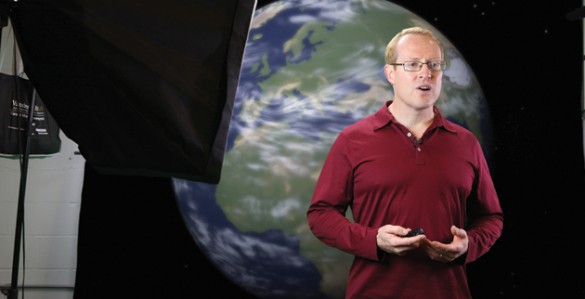
Professor of Computer Science Doug Schmidt films a video for Coursera. (Susan Urmy/Vanderbilt)
Constant innovation helped make one of the first massive open online courses, or MOOCs, at Vanderbilt more like a “real class” and benefited faculty and students by improving on-campus teaching, according to Douglas Schmidt, professor of computer science and of computer engineering at Vanderbilt.
Since MOOCs are likely to become a key avenue of education for future software professionals in academia and industry, tracking these first forays into the platform can provide important information for future course development, said Schmidt.
Schmidt, who taught one of Vanderbilt’s initial MOOC offerings — a free, open course on Coursera called Pattern-Oriented Software Architectures for Concurrent and Networked Software (POSA), will present a report on the topic next month at SPLASH 2013, a conference on software construction and delivery.
More than 31,000 students enrolled in the POSA MOOC, and 20,000 logged in and participated in some way. About 1,600 of those participated at the highest level, receiving a statement of accomplishment.
“Even having around 1,600 students complete the POSA MOOC is notable,” noted Schmidt, “since it would take us 20 plus years to teach that many undergraduates at Vanderbilt.” Even the students who didn’t obtain the statement of accomplishment learned a great deal, according to assessments in a the SPLASH 2013 paper titled “Producing and Delivering a Coursera MOOC on Pattern-Oriented Software Architecture for Concurrent and Networked Software.”
Among the impressive data collected during the 10 weeks of class: Students accessed the on-line video lectures 464,498 times and attempted on-line quizzes 37,817 times. Students completed 13,220 assignments in six different programming languages and conducted 45,649 unique peer-graded assessments.
Among the observations and lessons learned:
- An enormous amount of time was needed for content preparation before the launch and for adaptations during the course. A side benefit was the improvements that these preparations brought to faculty teaching of existing Vanderbilt courses on the same subject matter.
- Assessing student performance on design-oriented projects was more difficult than assessing fact-based performance.
- Several innovations helped make the POSA MOOC more like a “real” course, including virtual office hours that connected Schmidt with his MOOC students via Google Hangout and YouTube, crowd-sourced programming assignments, and grading calculators.
- The level of diversity among the student body was both challenging and rewarding. A solution to the divergent levels of experience was to create sequenced MOOCs.
To that end, Schmidt and Jules White, assistant professor of electrical engineering and computer science, have teamed with University of Maryland faculty member Adam Porter to present two-part sequenced MOOCs, to begin Jan. 6 with the Maryland course, “Programming Handheld Systems with Android.” It will continue March 10 with the Vanderbilt course, “Pattern-Oriented Software Architecture.” Students will learn how to develop a mobile app and how to connect it to a computing cloud. Each segment of the course will be 8 to 10 weeks long. Like all Coursera classes, the sequenced courses are free and open to all.
Visit the Vanderbilt Digital Learning website to learn more about the university’s digital learning initiatives. Visit the Coursera website to learn more about Coursera and to register for classes.
Read more about education research underway at Vanderbilt’s School of Engineering.
Contact:
Jennifer Johnston, (615) 322-NEWS
jennifer.johnston@vanderbilt.edu